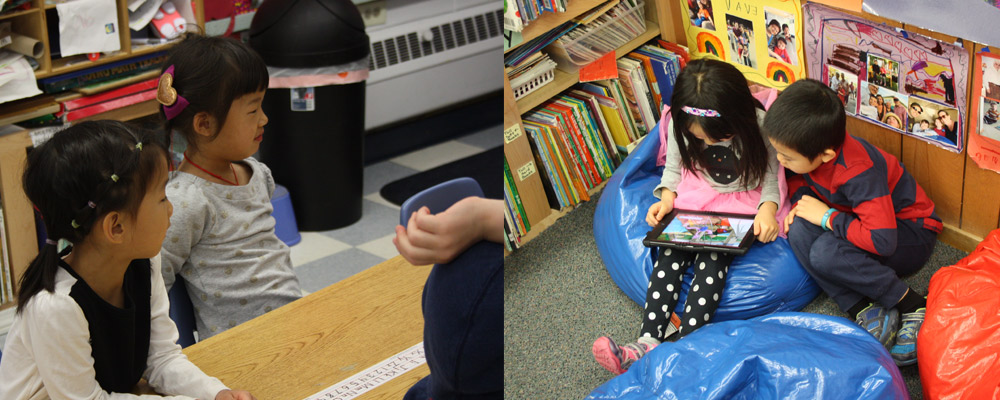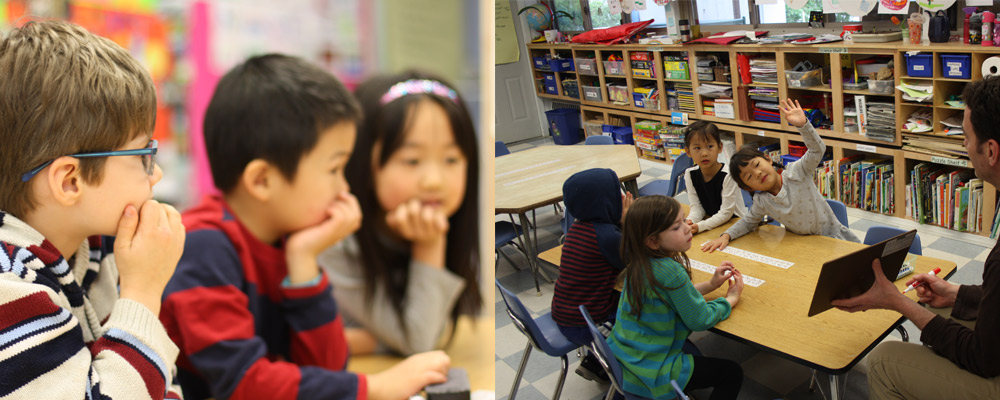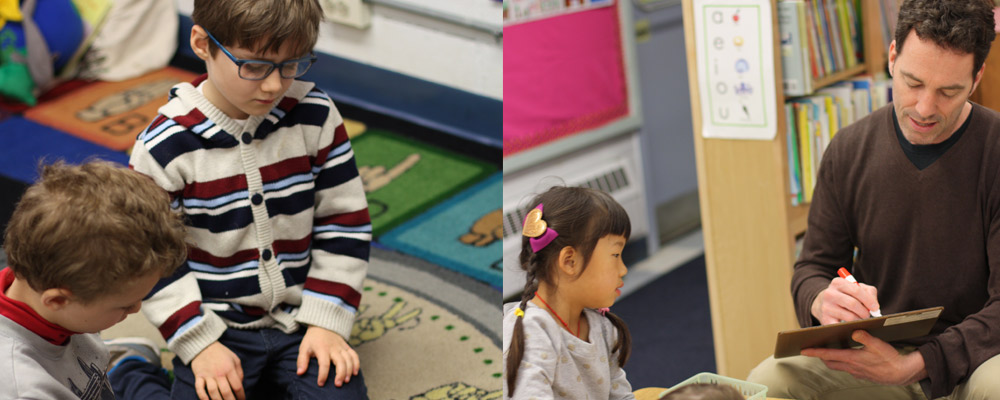Our Curriculum
The Barbereux School provides an environment conducive to the natural development of young children. We believe education is a process of unfolding rather than acquiring, and little children learn best through many play-based opportunities that allow them to manipulate and explore their environment and ideas. The act of learning through discovery makes the knowledge much more meaningful. The teacher’s main goal is to set up the classroom and guide the child towards discovery.
For the purpose of identifying the skills we want children to acquire, the following curriculum is divided by subject/developmental area. At Barbereux, we believe our curriculum is a living document that is continually updated as the children and world at large change over time.
Language Arts
Learning Objectives:
- Alphabet Knowledge and recognizing letters order of the alphabet.
- Phonological awareness including letter sounds, rhymes.
- Concepts about books (front/back, left right, etc.)
- Elements of story structure
- Phonemic Awareness including segmenting, blending syllables,
- Phonemes, onsets, rimes.
- Reading comprehension
- Engage in shared and independent reading of familiar predictable text
- Use descriptive/background info in stories to judge and evaluate key information
Examples of Activities:
- Respond to literature through art, drama, music, writing, puppetry, oral reading, reciting.
- Create class stories based on the patterns of books read and class experiences.
- Listen to a variety of literature read aloud.
- Read literature aloud with teacher, peers, and independently.
- Read at home for pleasure, information, and appreciation.
- Recite poetry and stories read and/or retell in own words.
- Discuss how stories read relate to self, family, friends, school, community, and the world.
Genres Studied:
- Folktales and Fairytales
- Periodicals/newspapers related to curriculum
- Picture books
- Fiction
- Nonfiction
- Poetry
- Biographies
- Emergent and beginning reader books
Learning Objectives:
- Use inventive spelling, based on sound, initial consonants and some ending sounds.
- Spell sight words correctly
- Begin to write simple sentences
- Use drawing and writing to convey meaning and provide information.
- Write and match upper and lowercase letters.
- Learn to organize ideas sequentially
- Begin to learn consistent letter formations and appropriate use of spacing between words.
- Represent stories through pictures, dictation, written words, and play
- Write own name
Examples of Activities:
- Write for a variety of purposes, using a variety of formats including stories, short reports and poetry.
- Keep a daily journal of ideas and activities
- Receive instruction in letter formation, phonics, and phonemics, with whole group, in small groups and individually (to meet individual developmental level of each student).
- Write and create books, with the class and individually, on a variety of topics.
- Play letter, word, and language games under teacher direction during class and without teacher during free-play
- Write chart stories, lists, etc., with whole group and in small groups
Objective: Speak Effectively
- Begin to identify various purposes for speaking.
- Use standard English in a manner that is appropriate for age level.
- Develop a vocabulary that is appropriate for age level.
- Participate in various informal and formal speaking situations.
- Use language to communicate wants and needs.
- Communicate new information learned.
- Participate in class discussions
Objective: Listen Effectively
- Identify various purposes for listening effectively
- Recall content of messages received
- Use appropriate audience/listener responses
- Develop strategies for good listening
- Ask appropriate questions of a speaker
- Demonstrate ability to comprehend speech and meaning in various situations
- Follow 2-3 step directions accurately
Examples of Activities:
- Conduct brainstorming sessions
- Retell stories in sequence
- Listen to, bring or tell the joke or riddle of the day
- Create add-on stories with peers
- Memorize and recite poetry
- Read aloud to teachers and peer
- Respond to teacher read selections of literature
- Show and tell
- Observe and discuss works of art: line, form, color, shape, etc.

Math
- Counting
- Number recognition
- Sequence numbers to 100
- Count by twos, fives, and tens to 100
- Begin to write numerals
- One to one correspondence
- Use ordinal numbers
- Match number to sets of objects
- Compare number values to one another
- Count On and Backwards
- Use strategies for adding and subtracting
- Identify 1/2, 1/3, 1/4 using models and symbols
- Begin add and subtract objects and numbers
- Solve simple math problems mentally or with objects
- Experiment with number stories
- Learn to use estimation techniques
- Know place value of ones and tens
- Understand the symbols +, -, and =
- Begin to understand the concept of zero
- Skip count by 2, 5, and 10
- Identify and create square, rectangle, triangle, circle
- Classify objects by shape
- Identify shapes in our environment and their purposes
- Describe attributes of shapes
- Explore concepts of congruency and symmetry
- Begin to know 3-dimensional shapes
- Sort by color, shape, size or use
- Describe how or why a set of objects is sorted
- Arrange objects by size
- Identify smallest and largest
- Collect and record observations of particular things over periods of time
- Display and analyze data in a variety of methods
- Interpret a variety of graphs
- make pictographs, venn diagram and bar graphs
- use proper terminology to discuss data and graphs
- Count with tally marks
- Predict number of objects in a group
- Predict longest, heaviest, etc.
- Use a variety of nonstandard and standard objects to measure for a variety of reasons
- Understand how to use a scale to measure weights
- Use comparative language
- Measure length, size, weight, etc.
- Measure by inches, feet and centimeters
- Read and use a monthly calendar
- Use thermometer to measure temperature
Money:
- Identify coins and their values
- Count out prices using pennies and other coins
- Understand value and use of money
Time:
- Identify times of day on the hour and at the half hour on circular
- Gain awareness of time by participating in daily activities
- Discuss elapsed time concepts
Patterns:
- Complete, copy and create new patterns using:
- manipulatives
- sound
- movement
- Identify missing part of a pattern
- Use a variety of math and sorting manipulatives daily including puzzles, shapes, peg boards, Unifex cubes, etc
- Use measuring tools daily include rulers, scales, kitchen tools; improvise measuring devices
- Play a variety of age appropriate board and card games
- Use math throughout the day, such as when setting the snack table or taking attendance
- Listen for math terms and ideas used as teacher and peers engage in daily conversation
- Participate in cooking and baking projects
- Participate in daily math exercises created to meet individual level of each student, that focus on developing particular math skills
- Participate in critical and creative thinking games, exercises, puzzles, etc. (some introduced by teacher and some created by students individually and collectively)
- Apply math concepts and relationships in other subject areas
Social Studies
- Become aware of social and cultural diversity in the world
- Discuss and explore how to think about and seek solutions to present and future social and political problems
- Distinguish between past, present, and future
- Develop ability to make decisions based on exemplary values
- Explore various ways and means to go about solving problems
- Learn what a responsible citizen is and how to be one in school, community, and the world
- Understand basic principles of government such as leadership, fairness, and cooperation
- Understand simple economic principles, such as buying/selling, trading, and integrity
- Understand simple geography concepts such as city, state, country, continent, and oceans
- Demonstrate an awareness of our community and its participants/workers
- Know address and phone number.
- Prominent, historical, and contemporary figures
- Our country and its symbols
- Sources and types of food, clothing, shelter
- Geography (maps and basic geography features)
- History of neighborhood and country
- Community Workers
- Local and National Holidays
- Families
- Native Americans.
- Celebrate cultural holidays that are meaningful to one or more of the children/teachers
- Create a class cultural book, which includes a page about each family or each culture represented in the class
- Read and discuss simple books about cultural holidays, foreign cultures, and diversity
- Explore the diversity of classroom and world through posters, artwork, songs, books, and play items
- Discuss and/or invite parents to come speak about or demonstrate appropriate cultural/family activities
- Participate in voting activities
- Role play commercial activities such as buying and selling
- Use a variety of maps as references
(Kindergarten and first grade do the same science and social studies units. Children who attend two years, do not repeat duplicate activities.)

Science
- Learn distinguishing characteristics of non-living and living things
- Acquire skills of scientific observation
- Understand the concept and process of cause and effect
- Make predictions; discuss whether they are based on personal experience, scientific fact or speculation/intuition
- Learn to question: Utilize inherent sense of wonder to formulate scientific hypotheses
- Understand and practice the process of experimentation: hypothesis, test, conclusion
- Analyze, question and evaluate data
- Recognize, appreciate, articulate and record scientific discovery
- Begin to understand scientific classification
- Use scientific language, tools, and technology
- Learn and follow safety procedures.
- Living versus non-living
- Solids, liquids, gasses
- Our earth and environment
- Conservation and Recycling
- Weather and seasonal cycles
- Hygiene and nutrition
- Force and motion
- Simple machines
- Astronomy
- Biology and ecology (species and classes of animals)
- Plants
- Nature walks throughout the year (During each walk, discuss what we discover. Back at school, extend activity by reading books about what was discovered, drawing pictures or creating a class book from pictures.)
Maintain a science table for items to explore or research such as rocks, seashells, flowers, plants, seeds - Grow seeds inside and transplant them in late spring
- Participate in baking/cooking projects every other week
- Make “play dough” once a month and observe the changes
- Pursue in-depth science activities that correlate with the current unit
- Use fiction and non-fiction books, charts, discussions and experiments to explore topics/units in depth
- Make models of scientific objects
- Role play and illustrate scientific concepts
(Kindergarten and first grade do the same science and social studies units. Children who attend two years, do not repeat duplicate activities.)
Skills and Development
Learning Objectives:
- Identify elements/principles of design
- Demonstrate skills necessary to produce visual art
- Use appropriate vocabulary to describe art
- Recognize processes and tools
- Be familiar with artwork. representing historical periods and styles
- Recognize art forms that are important to a variety of cultural traditions
- Be introduced and engaged with a variety of art media
- Acquire a sense of pride about their art accomplishments
- Use creative arts as an avenue for self-expression
- Learn about famous artists and their work
Examples of Activities:
- Explore mediums of paint (oils, watercolors, tempera)
- Create original designs for printmaking and produce prints
- Create 3-D sculptures using various materials
- Use clay to create objects
- Explore techniques of drawing from life objects and imaginative design
- Use various media to create group and individual collages
- Construct structures using various building materials
- Use various media to create large cooperative murals
- Observe, discuss, compare and replicate various works of art from diverse sources and historical periods
Music:
- Move to music (live and recorded) mimicking the movements of animals (skipping, hopping, galloping) to match the music
- Sing with the piano, guitar, etc.
- Play rhythm sticks or other simple instruments to music
- Participate in creative dance activities
- Mimic rhythms by clapping hands, tapping rhythm sticks or other simple instruments
- Draw to music
- Free dance to music and learn simple dances
- Play games or act out stories to music
Drama:
- Role play characters from stories and real life situations
- Interact with other children in role play situations
- Act out various rhymes and stories in a formal and informal manner
- Create scenery and props to accompany role playing
- Develop improvisation skills
Goals:
- Recognize and name feelings
- Express feelings appropriately
- Learn how to treat adults and peers with respect
- Communicate effectively and appropriately
- Acquire good friendship skills such as sharing, taking turns, etc.
- Learn how to work and play cooperatively
- Develop problem-solving skills
- Develop self-reliance and self-control
- Develop initiative and independence
- Learn to follow classroom routines and rules
- Develop a positive self-concept
- Recognize and honor self-worth of others
Activities:
- Talk about and continually model appropriate manners. Acquiring these skills is an ongoing process
- Encourage the use of words instead of tears or physical means. We help them express to us what is wrong so we can help them solve problems
- Teach problem solving skills by modeling how to resolve conflicts peacefully, giving suggestions when there is conflict, or allowing the children to contribute ideas on how a problem should be solved
- Consistently read about and discuss friendship issues throughout the year
- Include the children in creating and maintaining the classroom rules and resolving classroom conflicts
- Provide activities where children can achieve success and help others achieve success
- Empower children to make their own decisions appropriately
Goals:
- Develop a variety of large-motor skills such as galloping, jumping, climbing, pedaling, hopping and skipping
- Develop fine motor control/skills
- Develop attention span for age-appropriate activities
- Know and apply the principles and components of health related fitness and nutrition
- Learn how to play safely and prevent illness or injury
- Understand the human body systems, how they function and interrelate
- Acquire skills needed to take independent care for personal hygiene needs
Activities:
- Large Motor: Outdoor play, indoor games and music/rhythm activities
- Small Motor: Cutting, stringing beads, puzzles, drawing, using pegboards, painting, doing lacing activities, etc.
- Attention span increases with age and a gradual exposure to longer and more complex group time as well as individual exposure to more complex activities
- Regularly discuss and read about safety, fitness and health practices.

